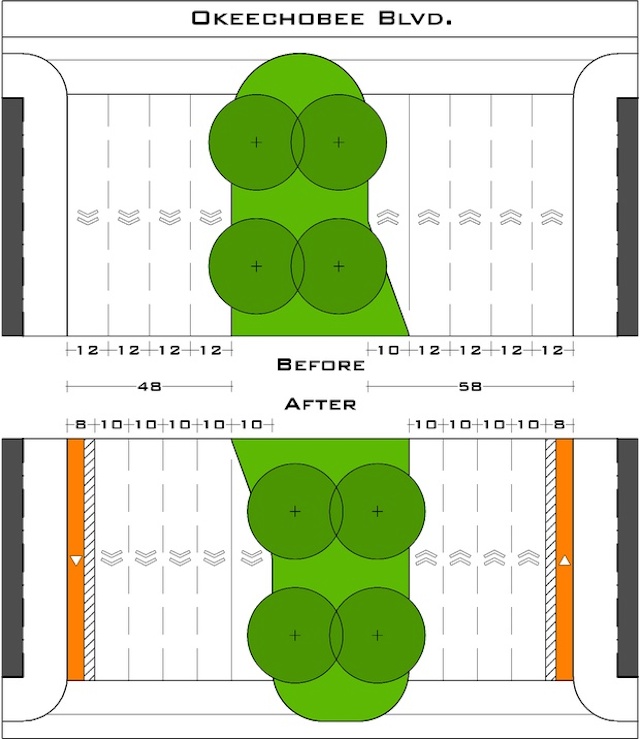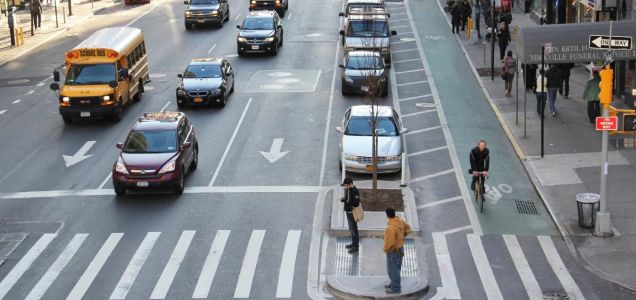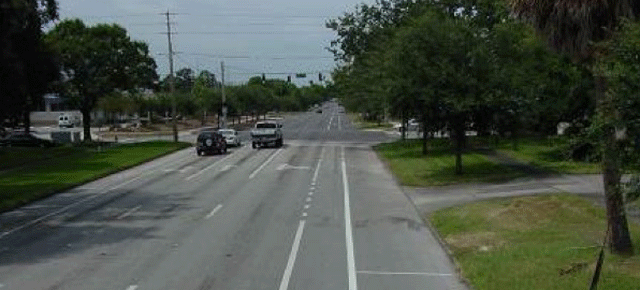We write about a lot of high-tech solutions for making roads safer: driverless cars, separated bike lanes, public transport, smarter signalling. Each of these are expensive to develop and difficult to adopt. What if there was a simple, cost-efficient way to guarantee safer streets? There could be: Make all traffic lanes just three metres wide.
That’s the argument made by walkability expert Jeff Speck over at CityLab. He is proposing what seems like a magic bullet for road safety: If traffic engineers would simply reduce lane widths to three metres, we’d have fewer roadway deaths, better traffic flow and more vibrant cities.
In most urban areas, a 3.6m lane is the standard for building new streets, and it has been for some time. Some cities — suburban areas, mostly — can go as high as 4.2m. Why so wide? The reason was a flawed belief generated around the development of the interstate highway system that wider lanes were safer for drivers.
When designing our freeway lanes, engineers had to design them for much higher speeds than the speed limit that was posted — because they knew people would speed. Therefore, freeways were designed with much wider lanes than necessary. But that doesn’t translate to city driving, says Speck:
Unfortunately, trained to expect this sort of behaviour, highway engineers apply the same logic to the design of city streets, where people behave in an entirely different way. On city streets, most drivers ignore posted speed limits, and instead drive the speed at which they feel safe. That speed is set by the cues provided by the environment. Are there other cars near me? Is an intersection approaching? Can I see around that corner? Are there trees and buildings near the road? Are there people walking or biking nearby? And: How wide is my lane?
So wider lanes change our behaviour, which alters the entire ecosystem of the street, argues Speck. Drivers go faster, endangering themselves and others. Pedestrians are forced to walk farther to cross wider streets, endangering themselves and others. People on bikes are forced to ride too close to fast cars, endangering themselves and others. It’s like a vicious circle of danger.
It didn’t always use to be this way, of course, and that’s where denser cities provide some great precedent. New York City, for example, has 3m lanes now. Drive through even older downtowns and you’ll probably feel perfectly comfortable on 2.4m lanes. Even in a 4WD. There’s simply no reason for traffic lanes to be much bigger than that.

In this Florida project by Speck’s firm, reducing lane widths to 10 feet made more room for a protected bike lane (in orange), which in turn makes for a safer sidewalk.
Safety isn’t the only benefit for narrower lanes. Speck cites an excellent study by Paul Moore and Theodore Petritsch, “The Influence of Lane Widths on Safety and Capacity: A Summary of the Latest Findings“, which disputes many long-held safety myths. (It’s a good read and written in clear, concise language, with illustrations.) But the study also points out the other, inherent benefits: Narrower lanes can create more room for streetcars, wider footpaths, additional trees, cafe seating, even well-integrated parking — all that stuff which makes a street far more pleasurable to be on when you’re not in a car. Which directly contributes to the health and well-being of local residents.

A road diet in Manhattan removes a lane of vehicular traffic for bike lanes. Narrowing lanes can achieve the same goal.
All of this has already been proven to work so well that it’s being implemented on a very small scale on American streets right now: This is essentially what transit planners are doing when they implement road diets, a popular method of removing a lane of vehicular traffic to add bike and pedestrian facilities while mitigating congestion — and doing things like adding bike lanes and improving pedestrian crossings have been proven to increase capacity.
But simply narrowing lanes (or requiring they only be three metres in the first place) is a much simpler idea than instituting a comprehensive road diet down the line. Road diets often includes additional costs for elements like curb extensions or bike lane construction — narrowing a street by restriping really only really requires some paint, as the example up top shows. And it does it in a way that will likely be imperceptible to drivers.
The Department of Transportation is set to release several new guidelines by the end of the year that will move the country away from a car-centric planning perspective and towards a culture of more shared streets. If they could add this one simple rule to their recommendations, it would create tremendous impact and very likely save lives. [CityLab]
Picture: Narrowing lanes to 3m in St Petersburg, Florida, by Michael Frederick, Manager Neighborhood Transportation and & Parking
